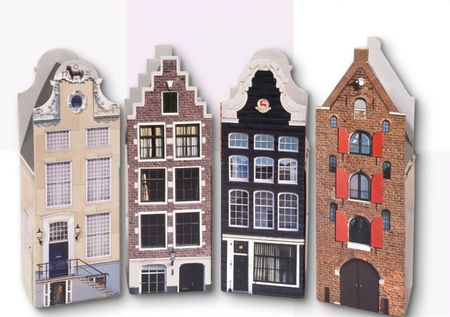L'histoire des pignons d'Amterdam
1620 – 1720
This was the gable-design adopted by merchants for warehousing and trade, rather than for residential use. Resembling a funnel top, the tuit gable became common allong the Brouwersgracht in 17th and 18th century.
After the decay of Dutch supremacy on international trading, many owners restored or simply replaced the more elaborately decorated gables to Tuit gables. Today they remain a trendy and most desirable place to live.
Ce fût le type de pignon adopté par les commerçants pour l'entreposage et le commerce plutôt que pour un usage résidentiel. Son sommet ressemblant à un entonnoir, le pignon bec est devenu commun dans le Brouwersgracht dans le 17ème et 18ème siècle.
Après la domination hollandaise sur le commerce international, de nombreux propriétaires les ont restaurés ou remplacés simplement par des pignons décorés de façon plus élaborée que le pignon bec. Aujourd'hui, ce sont des habitations branchées et les plus agréables à vivre.
The Step Gable (pignon en escalierl)
6120-1720
In the 17th century, the Step gable was very common in the Old Centre of Amsterdam wher vast numbers of this beautiful gable lined the canals and streets of a vibrant, busting merchant city.
These days there are only around one hundred left; due to the fact that in the 18th century many of the rich Dutch entrepreneurs adopted their gabled homes to a more modern architectural styule depicting grandeur and economic success.
Au 17ème siècle, le pignon en escalier était très commun dans le Vieux Centre d'Amsterdam longeant les deux rives des canaux et des rues d'une ville marchande pleine de vie.
De nos jours il n’en reste qu’une centaine ; en raison du fait qu'au 18ème siècle beaucoup de riches entrepreneurs néerlandais ont adopté pour leurs maisons des pignons au style architectural plus moderne, représentant leur grandeur et leur succès économique.
The Neck Gable ( Pignon de cou)
From the 18th century on the Neck gable became very popular and provided Amsterdam with a unique variation on gable trends. Adapted from other gable designs, the “Klauwstukken) or ornamental hoods enriched a very basic façade and shape.
The Neck gable embraced the architectural style of Louis XIV and became an example of the golden richness and Dutch Classicism within its time. The first Neck gable ever constucted was Herengracht 168. built in 1638, and still tands today.
Le Pignon de Cou (Halsgevel)
À partir du 18ème siècle le pignon de cou est devenu très populaire à Amsterdam et fourni de nombreuses variations sur les tendances du moment. Adapté d'autres designs de pignon, (le "Klauwstukken”), les chapeaux ornementaux ont enrichi les façades.
Le pignon de Cou s’est inspiré du style architectural de Louis XIV et est devenu un exemple
de la richesse et du Classicisme néerlandais pendant son temps. Le premier pignon de Cou jamais constuit était Herengracht 168. construit en 1638 et qui existe toujours aujourd'hui.
The Bell Gable (Pignon de cloche)
Dating from the 17th century and built over a long period of time, the Bell gable is aptly named as it follows the shape of a church bell.
The beautiful, ornate designs evolved over the course of the century becoming more decorative and more artistic as time went by. The widest Bell gable built during this period is Prinsengracht 359, which still stands today.
Datant du 17ème siècle et construit sur une longue période de temps, le pignon de cloche porte bien son nom car il suit la forme d'une cloche d'église.
Ce joli design orné de dessins a évolué au cours du siècle pour devenir de plus en plus décoratif et plus artistique, avec le temps. Le plus large pignon de cloche construit durant cette période est 359 Prinsengracht, qui est toujours debout aujourd'hui.
Contents / Contient :
10 Tulips Rembrandt mixed size: 12/+
Height / Hauteur : 40 cm
Planting time / Plantation : September – December
Flowering period / Floraison : April – May
Plant 10 cm apart and 10 cm deep / profondeur de plantation 10cm / distance 10cm
Plant in any garden soil with good drainage. Tulips may be left in the soil (but flowering degenerates); they can also be lifted after the foliage fades, stored at normal summer temperature and replanted in autumn.
Planter dans n'importe quel sol de jardin bien drainé. Les tulipes peuvent être laissée dans le sol (mais la fleuraison dégénère); elles peuvent aussi être retirées après que le feuillage soit fané. Conservé dans un endroit frais et replanté en automne.


/https%3A%2F%2Fprofilepics.canalblog.com%2Fprofilepics%2F2%2F2%2F220100.jpg)



/https%3A%2F%2Fassets.over-blog.com%2Ft%2Fcedistic%2Fcamera.png)
/https%3A%2F%2Fstorage.canalblog.com%2F26%2F29%2F256113%2F127131368_o.jpeg)
/https%3A%2F%2Fstorage.canalblog.com%2F56%2F65%2F256113%2F122851951_o.jpeg)
/https%3A%2F%2Fstorage.canalblog.com%2F52%2F33%2F256113%2F62419688_o.jpg)
/https%3A%2F%2Fstorage.canalblog.com%2F35%2F48%2F256113%2F14030623_o.jpg)
/https%3A%2F%2Fstorage.canalblog.com%2F68%2F55%2F256113%2F13013933_o.jpg)